Aloe Veras thrive in desert areas with the full sun. They can tolerate droughts and warm temperatures well. But, can they bear cold weather? Let’s find out.
Being succulent, aloe vera plants cannot endure cold temperatures and frost. The ideal temperature range is between 55-80°F, but they can tolerate temperatures as low as 40°F. If the temperature falls below that, the plant will likely suffer from cold damage resulting in wilting of the plant.
If your region gets low temperatures during the winters, you should grow Aloe Veras in pots to bring them indoors.
However, if you wish to keep them outside in winters, try growing cold-hardy Aloe Veras. They can endure temperatures of nearly 20-25°F.
If you wish to know about the cold tolerance of Aloe veras, this guide can help you. We will discuss their cold tolerance, signs of cold damage and freezing, how to fix it, and some winter care tips.
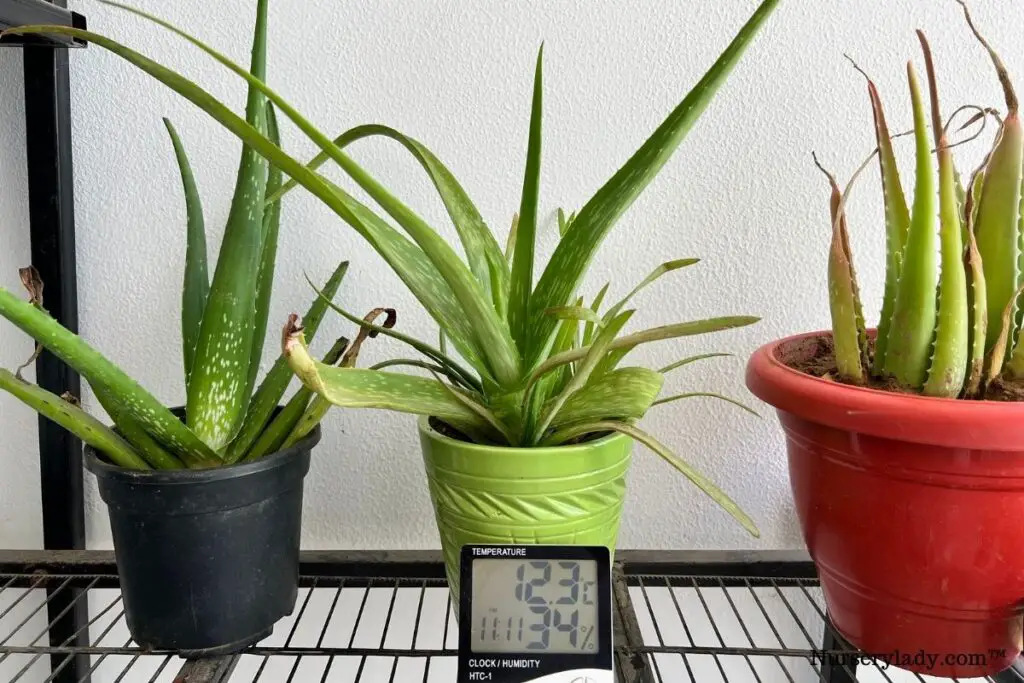
How much cold can Aloe Veras tolerate?
Generally, Aloe Veras grow best when the temperature stays between 55°F and 80°F.
At 60°F, they will grow busily.
Being desert plants, Aloes cannot tolerate too much cold weather.
Generally, most gardeners grow them in pots to bring them inside during the winters.
It is not the same for all.
If your area receives mild winters or belongs to zones 8-11, you can keep them outside.
You can grow Aloe vera in the ground if your area temperatures are around 50-60°F.
You should know the temperature range of your area during the winters.
From the second half of fall, when the temperature starts dropping, gradually move them indoors.
Acclimatization is important.
Or, you can grow them as houseplants only.
Then you don’t have to bring them inside separately.
Only ensure that they are getting enough sunlight.
Use artificial lights if needed.
Don’t keep them in an air-conditioned room or near fans.
Always keep them in a room having an average temperature.
Also read: Aloe Vera Temperature Tolerance: Ideal Temperature+Keeping Them Safe
How cold is too cold?
Most Aloes cannot tolerate temperatures below 40°F.
Some cold-hardy Aloe Veras can bear up to 20-25°F.
Below this range will cause frostbite and freeze them.
Aloe Veras have some gel-like liquid in their leaves.
Exposing Aloe Veras to extremely low temperatures for a long time will freeze this gel and destroy the plant cells and tissues.
Can I keep Aloe Veras outside in the winter?
It is better to keep Aloe Vera indoors during the winters.
But, you can keep them outside if your living area gets mild winter with temperatures of 50-60°F.
You can also keep them outdoors at night if the temperature remains the same.
But, if the temperature drops below 40-50°F at night, you must bring them indoors to save them from frost or freeze damage.
If Aloe Vera is planted in the ground, cover them with a frost cloth so that the frost cannot touch them.
Why does Aloe Vera get damaged during a cold?
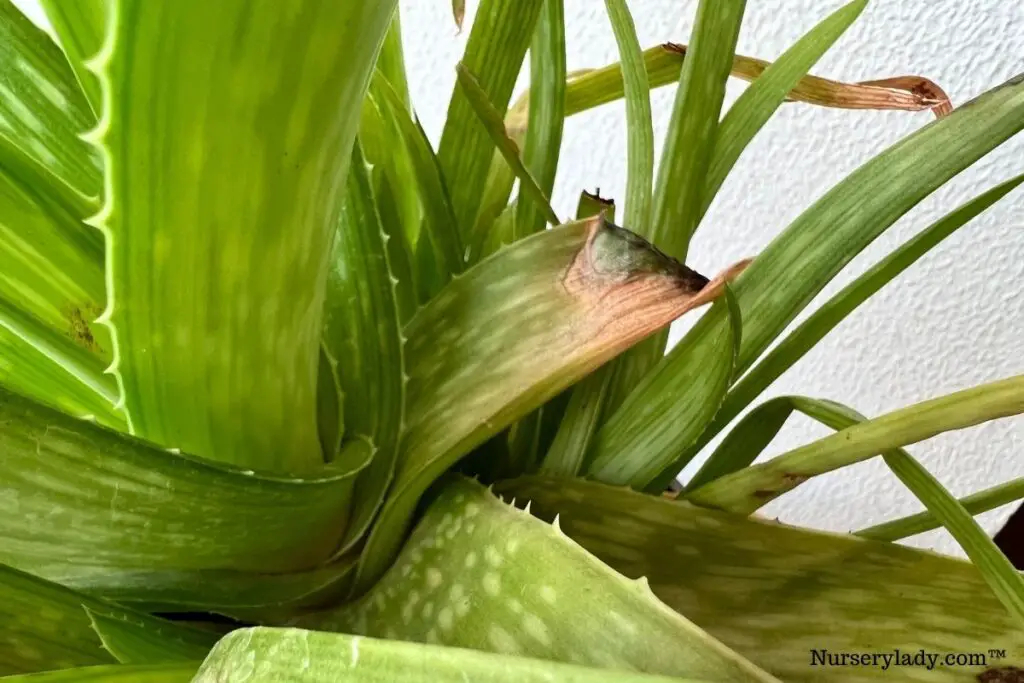
Aloe Vera succulents originate from the regions of the Arabian Peninsula where the weather is both tropical and semi-tropical.
During hot climates, the plant will easily thrive outside in the ground the whole year.
In the spring and summer, they will grow busily in most regions.
There are various factors responsible for which they cannot tolerate frosty weather.
The leaves of Aloe Vera are thick because they carry gel.
This gel is used for various medicinal purposes like sunburns or skincare.
These gels contain glycoproteins, and most of it has water.
Due to the 99% presence of water in the leaves, Aloe Vera gets frozen when exposed to low temperatures outside.
The cells and tissues of the plant get destroyed, thus making the plant weak.
Types of cold damage
The Aloes will have two types of damage during the cold winters:
- Frost damage
- Freeze damage
By now, it is known that Aloes enjoy warm temperatures and they are sensitive to cold.
Being habituated to growing around warm temperatures, Aloes struggle during the cold.
Frost damage will happen if your Aloes got exposed to temperatures below 40°F for some time.
However, frost damage is not life-threatening to Aloes.
Some leaves will turn brown and shrivel.
The remaining leaves will be green.
There is still a chance to fix the problem and treat the plant.
Freeze damage is not as simple as frost damage.
If the plant gets exposed to very low, frozen temperatures for a long time, the plant will freeze inside and out.
Revival is impossible.
A sign of a freezing plant is black and crispy leaves.
In freeze damage, to understand whether the damage level is severe or not, you have to wait for weeks.
A few hours outside is fine, but if they stand outside at night during too low temperatures, there is less chance of recovery despite you trying hard to treat them.
Aloes will also get a cold shock if placed close to air conditioners or fans except for the winter.
What are the signs of cold injury?
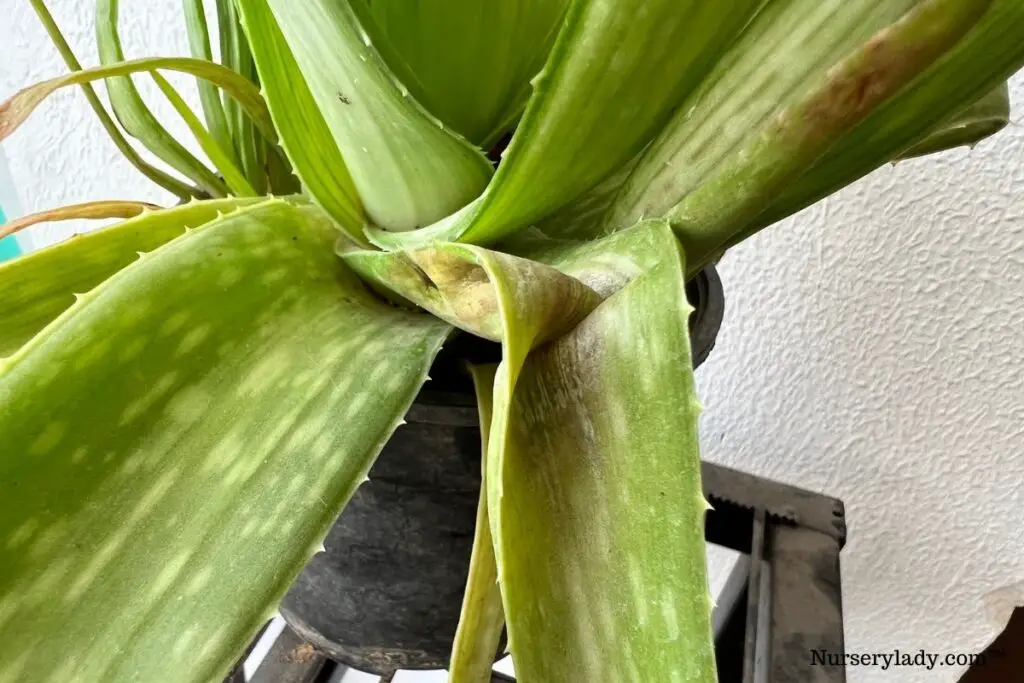
When you keep the plant outside at low temperatures, it will get a cold injury.
When this happens, the plant will display certain signs.
- Few brown leaves are due to frost.
- They will feel mushy and squishy.
- The leaves will have a glassy appearance.
- The leaves will turn yellow, white, or red near the veins. These are generally the dead cells due to freezing.
- Dark spots and rot
- Black leaves and eventually crispy and shriveled due to freezing.
- Due to the tissue and cell damage, the leaves will become droopy. The cells will lose their rigidity.
- The signs of frost and freeze damage are more or less the same. The difference lies in the damage intensity. The next point will tell you how to identify the damage level.
Looking for gardening supplies? We have tested 100's of products before recommending them to you guys. Check out our best pick below:
| Image | Gardening Supplies | Best Price? |
|---|---|---|
 Top
Top Top
Top | Raised Garden Bed Kit | Check On Amazon |
 | XLUX Soil Moisture Meter, Plant Water Monitor, Soil Hygrometer Sensor for Gardening, Farming, Indoor and Outdoor Plants, No Batteries Required | No Results |
 Top
Top Top
Top | 82 Pcs Garden Tools Set and Extra Succulent Tools Set | Check On Amazon |
 | Joeys Garden Expandable Garden Hose with 8 Function Hose Nozzle, Lightweight Anti-Kink Flexible Garden Hoses, Extra Strength Fabric with Double Latex Core, (50 FT, Black) | No Results |
 Top
Top Top
Top | Dual Chamber Compost Tumbler | Check On Amazon |
 Top
Top Top
Top | Sunnyglade Plant Stakes | Check On Amazon |
 Top
Top Top
Top | Organic Cold Pressed Neem Seed Oil | Check On Amazon |
 Top
Top Top
Top | Mighty Mint Gallon :-Insect and Pest Control Peppermint Oil | Check On Amazon |
 Top
Top Top
Top | Scotts DiseaseEx Lawn Fungicide | Check On Amazon |
 Top
Top Top
Top | Jacks Classic 20-20-20 All Purpose Fertilizer | Check On Amazon |
 Top
Top Top
Top | 30,000 Seeds Pollinator Attracting Wildflower Mixture | Check On Amazon |
 Top
Top Top
Top | Survival Vegetable Seeds Garden Kit-Over 16,000 Seeds | Check On Amazon |
How to check the damage level?
Due to extreme cold, the leaves freeze.
But if the damage level is not to a great extent, you can revive the plant back.
However, you should know that they won’t come back if they freeze too much.
They should not be grown outside in places with colder climates.
Check the amount of frost.
If the plant has received little frost, you can remove the damaged leaves.
After some time, they will recover.
Also, shift the plant to some warm place.
If the entire plant got covered with frost, it is better to discard the old one and start growing a new Aloe Vera.
See the leaf color
The only way to identify frost or freeze damage is from the look of the leaves.
If some leaves have turned brown or shriveled, but others are still green, it is frost damage.
You can remove the leaves and take care of the plant for revival.
But, if all the leaves have turned brown, the plant becomes irrecoverable.
Also read:
- Why Is My Aloe Vera Plant Turning Yellow? (10 Causes+Fix)
- Why Is My Aloe Vera Plant Turning Black? (9 Causes+Fix)
Will Aloe Vera come back after freezing?
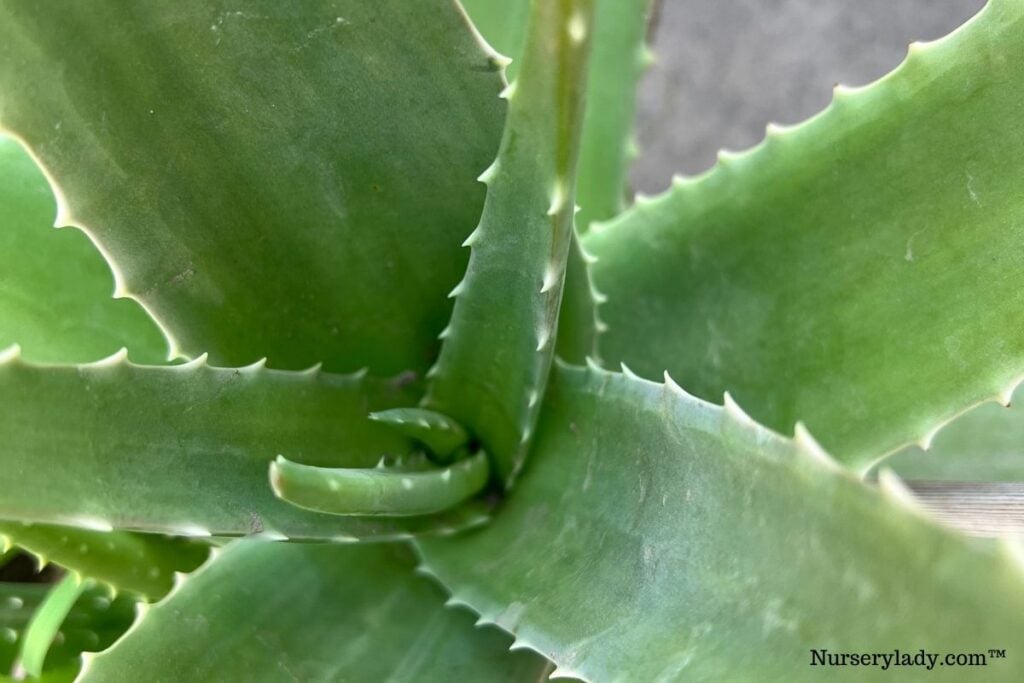
Freezing is more dangerous to Aloe Veras than frost.
There are rarely any chances of recovery.
But if they have frost damage, you can still bring the plant back within a few weeks.
Not all, but some cold-hardy Aloe Vera species will come back from slight freezing.
How to revive a cold-damaged plant?
If the damage level is within limits, you can save the plant in the following ways:
Stop watering
Aloe Veras are not trained to deal with cold or frost.
They naturally grow around a warm climate.
So, when the plant gets frost injury by mistake, it is better to stop watering them for some weeks.
The evaporation rate decreases to a great extent in the winters.
So, the soil would stay wet for a long time.
Watering them further will only hinder the plant’s recovery.
Also read: How To Water Aloe Vera Plant? (How often, Summer, Winter)
Prune the affected leaves
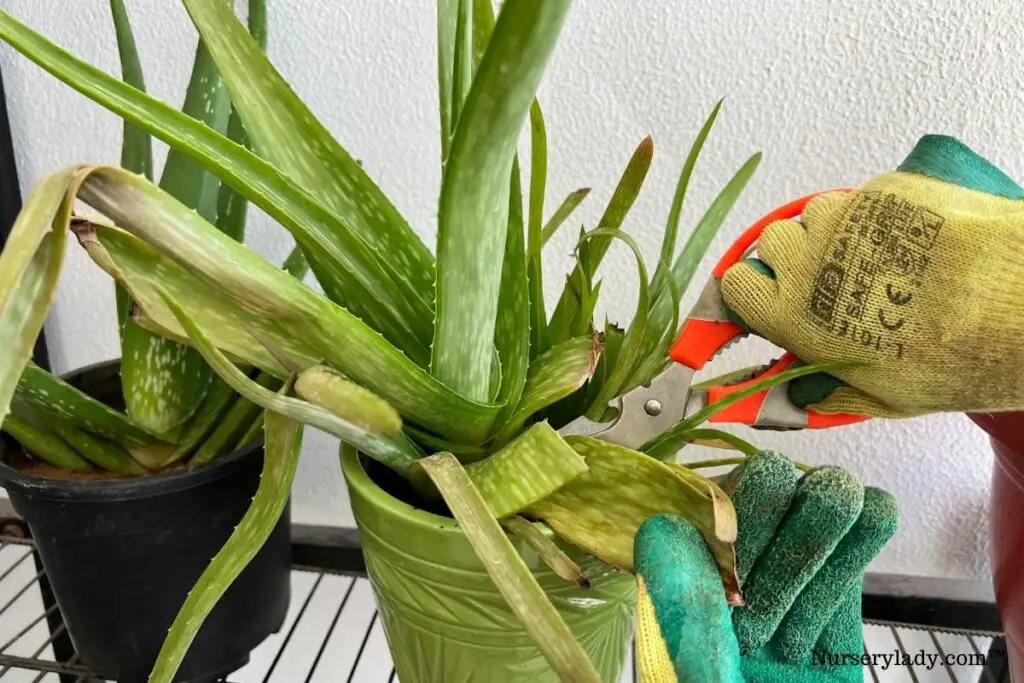
Generally, Aloes are pruned after their flowering seasons.
But, in such conditions, you can always remove the dead and damaged leaves due to frost damage.
Take a sharp knife or pruner, disinfect it, and cut off the discolored leaves.
Be careful not to harm the green leaves.
Keep Aloe Vera around a warm environment.
After pruning off, shift the plant to a warm place.
But not close to heaters or radiators.
Keep them in a room where the average temperature would stay within 50-60°F.
After a few weeks, you will know whether they are on the path to recovery or death.
Don’t bother them further with watering or fertilizing.
If the plant is about to recover, you will understand it when you see new leaf growth.
Use agricultural sulfur
With no watering, pruning off the leaves, and shifting them to warm areas, you can further improve the plant’s health by applying some agricultural sulfur.
Sprinkle some to the areas where you have cut off the damaged brown leaves.
It will keep the plant alive.
How to make Aloe Vera survive winter?
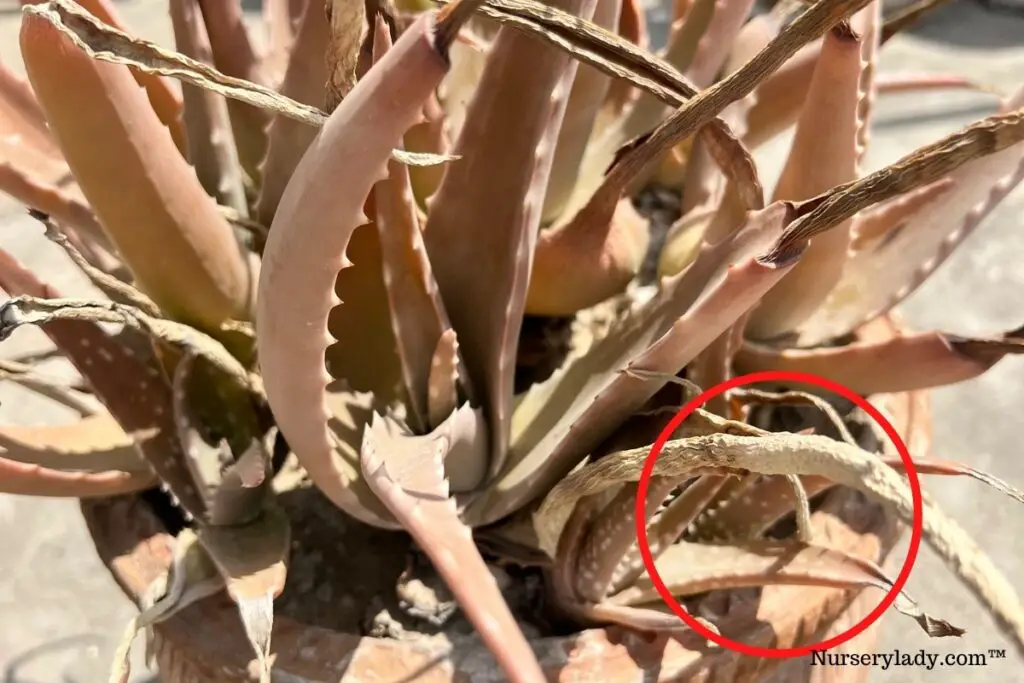
To keep Aloe Vera alive in the winters, you need to follow some winter care tips and precautions when the temperature drops.
Taking care of Aloe Vera during the winters is not at all difficult.
You only need to follow a few steps.
Below is a guide that might help the Aloes survive the winter.
Let’s have a look:
Sunlight
Ensure the plant is getting 5 to 6 hours of direct sunlight daily.
Since the sun level is low enough in the winters, the direct sun won’t harm them.
Instead, it will keep them warm and amend the temperatures.
Remove the shading nets if you have used them during the summers.
Keep them near the south or west-facing window if the plant is indoors.
Don’t use any sheer curtains.
Due to low sun levels, they won’t burn the Aloes.
But keep them a few feet back so that the cold cannot touch the leaves.
Also read: What Kind Of Light For Aloe Vera Plants? (Full sun, Shade, Or Partial Light?)
Soil and water
Using fast-draining soil can drain the moisture and keep it almost dry.
However, some aloe species can tolerate wet soils to some extent.
Dry soil is very important for Aloe Veras during the winters.
Water the Aloe Veras rarely.
As the evaporation rate is slow, the coil won’t dry quickly.
Check the moisture level before watering.
Allow at least the top 2-3 inches of the soil to dry.
Watering once a month would be enough.
Stop watering during the frost.
If, by chance, the plant got frost damage, stop watering for a few weeks until the problem is resolved.
Don’t bother them with fertilizing.
Also read: What Type Of Soil For Aloe Vera Plant? (+Ideal Soil Mix)
Bring them indoors
Bring Aloe Vera indoors if the temperature drops below 40°F at night.
You can keep them outside to give them sufficient warmth from the sun in the morning.
But, at night, you should bring them inside to protect them from frost and freeze damage.
Also read: Is Aloe Vera Indoor Or Outdoor Plant? (+Care Difference)
Grow in pots
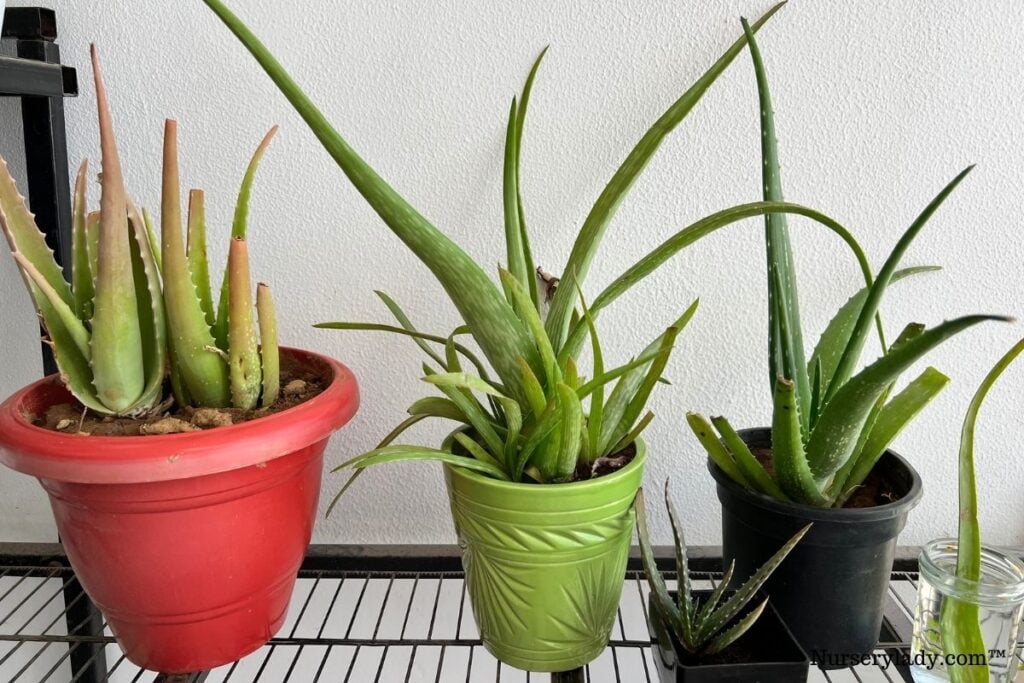
If your living area gets low temperature during the winters, grow Aloe Vera in pots.
If your Aloe vera is outside, you can bring them indoors during the winters, especially at night.
Prune off the cold-injured leaves
Sometimes, the plant might receive slight frost or freezing damage.
Remove those leaves with a sharp knife or scissors.
If many leaves are turning brown, don’t remove all of them.
That might create a problem in photosynthesis.
Shift the plant to a warm place, stop watering and fertilizing and give them their usual care.
When they show signs of revival, you can prune some dead leaves.
Cover the soil with stones
Add some small pebbles or stones to the soil surface.
This will help in many ways during the winter:
Don’t let the moisture evaporate fully.
It will keep the plant hydrated.
Trap the moisture in the soil, thus keeping them warm.
Stop the cold temperature from reaching the plant’s roots, thus saving them from cold shock.
Use frost clothes
If your Aloes are planted in the ground, you can use frost clothes to cover them.
These clothes are breathable and designed for succulents to keep them warm during cold climates.
Create a frame or border around the planting site to fix the cloth.
Ensure that the cloth doesn’t touch the plant or the leaves.
You don’t have to purchase the frame.
You can make it yourself with chairs, sticks, and wire hoops.
Make sure the cloth covers the whole planting site.
Acclimatize
Do it gradually if you want to shift the potted Aloe Veras from outdoors to indoors during the cold climate.
Similarly, while shifting the plant from inside to outdoor after the winter ends, be gradual.
Changing their locations gradually will make them get adjust to the different environments.
As a result, they won’t show any signs of stress.
Cold-hardy Aloe Veras
If you don’t want the Aloe Veras to suffer cold damages, grow some cold-hardy Aloes.
These can endure temperatures of 20-25°F.
No Aloes, including these cold-hardies, can tolerate temperatures below 20°F.
If your region receives a range below 20°F, don’t grow Aloe Vera or grow them as houseplants.
Some cold-hardy Aloe Veras are:
- Aloe brevifolia (Short-leaf Aloe)
- Aloe Arborescens (Torch Aloe)
- Aloe Capital var. Quartziticola
- Aloe marlothii (Mountain Aloe)
- Aloe Ferox (Cape Aloe)
- Aloe Microstigma (Cape Speckled Aloe)
- Hereroensis (Sand Aloe)
Final words
Though Aloe Vera can tolerate mild cold, it cannot endure cold temperatures below 30-40°F. If left outside, especially at night, your plant will get frost or freezing damage. It will even kill the plant.
Aloes will tolerate 50-60°F in the winters. You can grow them outdoors and on the ground if your area gets mild winter. But, in places with 30-40°F in winters, it is better to grow them as houseplants. You can still have them outdoors, but in containers, to bring them inside at night.
Protect your plant and follow the winter tips I shared to help them survive the winter. Always maintain a warm temperature around them, don’t bother them with watering and fertilizing. If possible, grow Aloes in containers. It will make things a lot easy.
Reference: NCBI, New York Botanical Garden, University of New Hampshire, University of Florida, Wikipedia.
